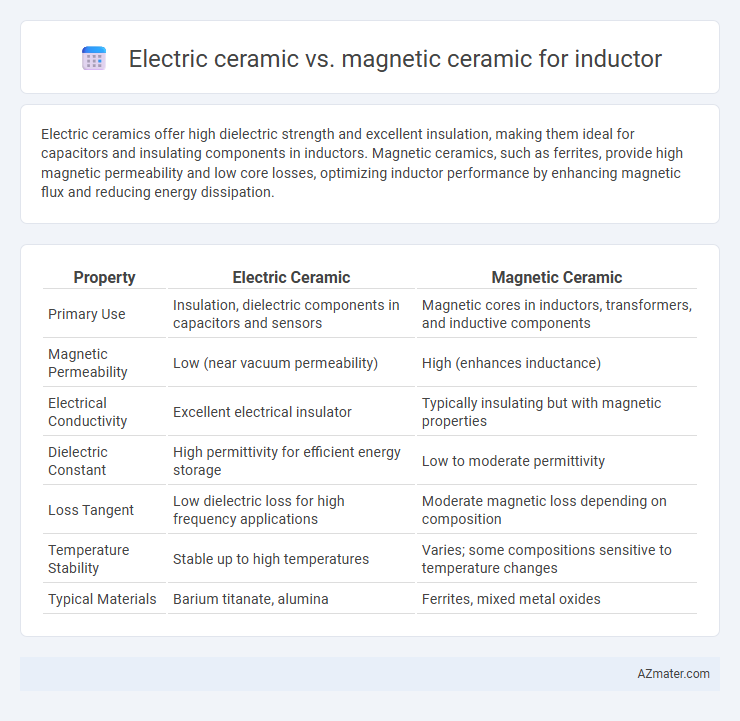Electric ceramics offer high dielectric strength and excellent insulation, making them ideal for capacitors and insulating components in inductors. Magnetic ceramics, such as ferrites, provide high magnetic permeability and low core losses, optimizing inductor performance by enhancing magnetic flux and reducing energy dissipation.
Table of Comparison
| Property | Electric Ceramic | Magnetic Ceramic |
|---|---|---|
| Primary Use | Insulation, dielectric components in capacitors and sensors | Magnetic cores in inductors, transformers, and inductive components |
| Magnetic Permeability | Low (near vacuum permeability) | High (enhances inductance) |
| Electrical Conductivity | Excellent electrical insulator | Typically insulating but with magnetic properties |
| Dielectric Constant | High permittivity for efficient energy storage | Low to moderate permittivity |
| Loss Tangent | Low dielectric loss for high frequency applications | Moderate magnetic loss depending on composition |
| Temperature Stability | Stable up to high temperatures | Varies; some compositions sensitive to temperature changes |
| Typical Materials | Barium titanate, alumina | Ferrites, mixed metal oxides |
Introduction to Ceramic Materials in Inductor Technology
Electric ceramic used in inductors primarily functions as a dielectric material with high permittivity, enhancing energy storage and insulation capabilities. Magnetic ceramic, such as ferrite, offers high magnetic permeability, improving inductance and reducing core losses in high-frequency applications. Understanding the distinct properties of electric and magnetic ceramics is crucial in optimizing inductor performance for electronic circuits.
Overview: Electric Ceramics vs Magnetic Ceramics
Electric ceramics, primarily composed of dielectric materials like barium titanate, excel in high-frequency insulating applications due to their high permittivity and low loss tangent. Magnetic ceramics, often made from ferrite compounds such as manganese-zinc or nickel-zinc, offer superior magnetic permeability and low eddy current losses, making them ideal for inductors in high-frequency power conversion. The choice between electric and magnetic ceramics for inductors hinges on their distinct electromagnetic properties, with electric ceramics serving mainly as capacitive elements and magnetic ceramics functioning as core materials to enhance inductance and efficiency.
Key Properties of Electric Ceramics
Electric ceramics for inductors feature high dielectric strength, excellent electrical insulation, and stability under varying temperatures, enabling efficient energy storage and minimal signal loss. These ceramics typically have low magnetic permeability, contrasting with magnetic ceramics designed for high permeability and inductance enhancement. Key properties such as high resistivity, low dielectric loss, and thermal resistance make electric ceramics ideal for applications requiring precision and reliability in insulating components of inductors.
Key Properties of Magnetic Ceramics
Magnetic ceramics used in inductors exhibit high permeability, low core losses, and strong magnetic saturation, enabling efficient energy storage and signal filtering in high-frequency applications. Their ferrite composition provides excellent thermal stability and electrical insulation, crucial for minimizing eddy currents and enhancing inductor performance. Compared to electric ceramics, magnetic ceramics offer superior magnetic coupling and reduced power dissipation, making them ideal for compact and high-efficiency inductors.
Performance Comparison: Inductance and Efficiency
Electric ceramic inductors typically offer higher inductance values with excellent efficiency due to low core losses and stable dielectric properties, making them suitable for high-frequency applications. Magnetic ceramic inductors, while generally exhibiting lower inductance, provide superior magnetic permeability and can handle higher magnetic flux densities, which enhances their efficiency in power applications and signal filtering. Performance comparison shows electric ceramics excel in minimizing energy losses at high frequencies, whereas magnetic ceramics deliver better efficiency under high current conditions and magnetic saturation.
Applications: Where Electric Ceramics Excel
Electric ceramics excel in high-frequency applications such as radio frequency (RF) circuits and microwave devices due to their low dielectric loss and stable permittivity. They are ideal for multilayer chip inductors and capacitors used in compact, high-performance electronic devices like smartphones and wireless communication systems. Their ability to maintain electrical insulation while supporting high dielectric constants makes them indispensable in miniaturized, high-frequency passive components.
Applications: Where Magnetic Ceramics Outperform
Magnetic ceramics excel in high-frequency inductors used in power electronics, RF circuits, and transformers due to their superior magnetic permeability and low core losses. These materials are ideal for applications requiring efficient energy storage and minimal signal distortion, such as in wireless communication devices and power supply units. Electric ceramics, while beneficial in insulating and high-temperature environments, rarely match the magnetic efficiency required for inductive performance in these specialized applications.
Thermal Stability and Reliability Analysis
Electric ceramics used in inductors typically offer superior thermal stability due to their high dielectric strength and low loss tangent, which minimizes heat generation during operation. Magnetic ceramics, while essential for high permeability and inductance, often suffer from thermal hysteresis and saturation effects that degrade reliability under fluctuating temperatures. A comprehensive reliability analysis shows that inductors with electric ceramic components maintain consistent performance over a wider temperature range, whereas magnetic ceramic inductors require careful thermal management to prevent performance deterioration and failure.
Cost and Manufacturability Considerations
Electric ceramic inductors typically incur higher manufacturing costs due to complex material processing and stringent quality controls required for high dielectric strength. Magnetic ceramic inductors benefit from more established production techniques, resulting in lower overall costs and easier scalability for mass manufacturing. Cost-effectiveness in magnetic ceramics often stems from abundant raw materials and simpler fabrication processes, making them preferable for large-volume inductor applications.
Choosing the Right Ceramic Material for Your Inductor
Electric ceramic materials, such as alumina, offer excellent insulation and high dielectric strength ideal for high-frequency inductors requiring low loss and stable performance. Magnetic ceramics, including ferrites, provide high magnetic permeability and low core losses, making them perfect for inductors used in power conversion and noise suppression applications. Selecting the right ceramic material depends on balancing factors like operating frequency, required inductance, thermal stability, and application-specific efficiency needs.

Infographic: Electric ceramic vs Magnetic ceramic for Inductor
 azmater.com
azmater.com